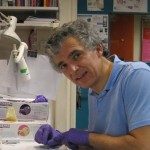Link to Pubmed [PMID] – 21925225
Hum. Immunol. 2011 Nov;72(11):1013-7
Although interleukin (IL)-2 and IL-15 share the common signal transducing receptor chains IL-2Rβ and γ(c) and give rise to the same signaling patterns in human natural killer (NK) cells in vitro, they differ in their effects on the development, activation, and proliferation of these cells in vivo. We have previously demonstrated that the activation of NK cells induces a cellular program characterized by the sequential transcription-regulated expression of IL-15 and IL-2 high-affinity receptors. We demonstrate here that these receptors induce different responses. IL-15 sustains the expression of its high-affinity receptor, leading to long-lasting STAT5 phosphorylation and BCL2 expression. By contrast, IL-2 induces the rapid disappearance of IL-2Rα and γ(c) chains when the gene transcription is downregulated, shutting down IL-2-responses as demonstrated by the absence of STAT5 phosphorylation and BCL2 expression.
